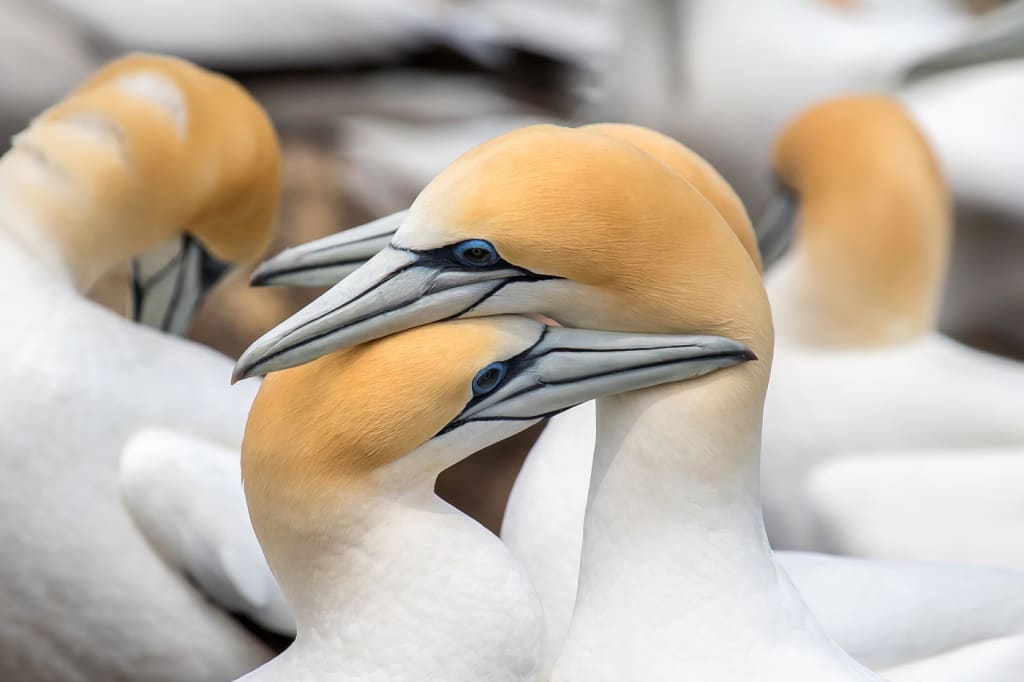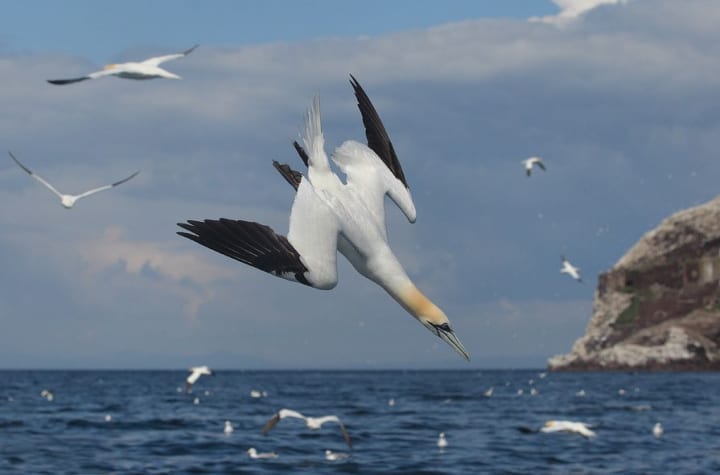Gannet
A seabird with a spectacular method of catching fish

The gannet (Sula bassana, or Morus bassanus) is a truly remarkable bird, for several reasons. It is the largest seabird indigenous to the British Isles, at up to 95 centimetres (37 inches) in length, and this is where up to 70% of the world’s population of gannets breed. The gannet is not the same species as the Cape gannet (Morus capensis), although they do have many features in common.
Appearance
The wings are long and narrow, with the wingspan up to 190 centimetres (75 inches), and almost translucent when the bird is seen hovering in the wind against a bright sky. The body and wings are white, with black on the outer wings. The head has a yellowish tinge and the bill is strong and spear-shaped. It takes four years for gannets to reach this colouring, with the youngest juveniles appearing to be black above and paler below, more white appearing in their plumage in successive years. Males and females have similar plumage, although their feet are slightly different, with the males having yellowy-green lines on them and females having bluey-green lines.
Breeding
Gannets live for much of the year at sea, arriving at their breeding grounds between February and April and leaving in September at the latest. The breeding grounds are mostly offshore rocks and islands in the northern and western isles, but there are some notable colonies elsewhere, such as Bempton Cliffs on the Yorkshire coast and Bass Rock in the Firth of Forth.
The breeding colonies are huge, with tens of thousands of birds huddled together, two or three per square metre, such that the rocks turn white with gannets. The nest is made of seaweed and pieces of driftwood, in which the female lays a single egg. This is incubated by both birds in turn for up to 45 days.
The egg has a particularly thick shell, and it can take the chick a whole day to peck its way out. It is blind for another two or three days, but born with a huge appetite that the parents satisfy all round the clock, both day and night. Food is pushed right down the throat of the chick, which gains weight rapidly, such that it will be heavier than an adult by the age of eleven weeks.
The young bird leaves the nest at 75 days, although it is not able to fly at this stage. In other words, it has to jump into the sea and swim away from the colony, having to fend for itself from now on. It can be another 30 days before it flies for the first time, many miles from the rock on which it was hatched.
Feeding
Clearly, young birds have to dive from the surface for their food, which will be herring, mackerel and sardines, but it is the feeding behaviour of adult, flying birds that attracts wildlife photographers from all over the world. When a shoal of fish is found, dozens of gannets will fly and glide overhead then dive straight down from a height of up to 40 metres, folding their wings back at the last second to enter the sea like an arrow. The gannet will not have targeted an individual fish, but will plunge to a depth of up to five or six metres and swim underwater to catch as many fish as it can.

Gannets are better at entering the water than leaving it, with much flapping of wings before they take off. A dive that does not result in a meal is therefore a loss of energy that cannot be afforded too often.
Although gannets are quite long-lived, with an average lifespan of 16 years and the oldest recorded bird being 37 years old, the constant diving from height into the sea eventually takes its toll and many gannets suffer from brain damage in old age. Death usually results from starvation when the bird can no longer dive.
Conservation
Gannets are on the amber list of threatened species, although this might be wondered at given the vast size of the colonies that can be seen. However, when fish stocks decline, seabirds are always going to be at risk, and it is the food supply for gannets and other species that is currently giving cause for concern.
About the Creator
John Welford
I am a retired librarian, having spent most of my career in academic and industrial libraries.
I write on a number of subjects and also write stories as a member of the "Hinckley Scribblers".






Comments
There are no comments for this story
Be the first to respond and start the conversation.